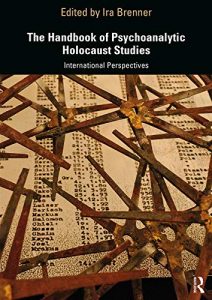Mourning
by Anna Ornstein, MD
Abstract
In order to make further comments on the mourning process in Holocaust survivors, I will use my mother’s, my father-in law’s, and my personal experiences as “windows” into the subjective experience of mourning following multiple and traumatic losses. In my two earlier publications on the subject (Ornstein, 2010 , 2016), I focused on the difference between mourning as this occurs in response to the death of a single individual under ordinary, civilized conditions, and mourning as this would have to be conceptualised when mourning is delayed following the loss of one’s whole family and community under traumatic conditions. In these publications, I described creativity as a transformative agent. Memorials, poems, music, memoirs, paintings, and sculptures that deal with the subject of mourning not only bring back the past but when read and/or viewed, the past is actively mourned. Survivors of communal disasters visit these sites and seek out these texts because of their power to elicit the dreaded but also deeply desired pain of grief. Much as it is dreaded, experiencing grief is also desired because it is only then that the numbness that isolates the bereaved from his/her surroundings can be overcome.
In The Handbook of Psychoanalytic Holocaust Studies: International Perspectives edited by Ira Brenner. Routledge, 2019, p. 74-80. (Fulltext can be requested from the library).
About the Book

This book is a unique compilation of essays about the genocidal persecution fuelling the Nazi regime in World War II. Written by world-renowned experts in the field, it confronts a vitally important and exceedingly difficult topic with sensitivity, courage, and wisdom, furthering our understanding of the Holocaust/Shoah psychoanalytically, historically, and through the arts.
Authors from four continents offer their perspectives, clinical experiences, findings, and personal narratives on such subjects as resilience, remembrance, giving testimony, aging, and mourning. There is an emphasis on the intergenerational transmission of trauma of both the victims and the perpetrators, with chapters looking at the question of “evil”, comparative studies, prevention, and the misuse of the Holocaust. Those chapters relating to therapy address the specific issues of the survivors, including the second and third generation, through psychoanalysis as well as other modalities, whilst the section on creativity and the arts looks at film, theater, poetry, opera, and writing.
The aftermath of the Holocaust demanded that psychoanalysis re-examine the importance of psychic trauma; those who first studied this darkest chapter in human history successfully challenged the long-held assumption that psychical reality was essentially the only reality to be considered. As a result, contemporary thought about trauma, dissociation, self psychology, and relational psychology were greatly influenced by these pioneers, whose ideas have evolved since then. This long-awaited text is the definitive update and elaboration of their original contributions.
About the Author
Anna Ornstein, MD, is a Supervising Analyst at the Boston Psychoanalytic Society and Institute, Professor Emerita of Child Psychiatry at the University of Cincinnati, a Training and Supervising Analyst at the Cincinnati Psychoanalytic Institute, a Lecturer in Psychiatry at Harvard University. She was born in Hungary in 1927. She survived deportation, ghetto imprisonment, the Auschwitz concentration camp, and the Parschnitz labor camp. In 2018, Dr. Ornstein received the Kravitz Award in recognition of her dedication to teaching about the Holocaust and the dangers of intolerance. Click here to watch her recent interview.
Previous Posts:
Randall H. Paulsen, MD (2019). Scientific Theory on the Couch: A Response to Scott C. Taylor. American Imago, 76(3), 405-411.
Bernard Edelstein, MD (2019). Introduction: Stumbling on our Past, Reflections on James Baldwin’s “My Dungeon Shook”. American Imago, 76(3): 295-300.
Don Lipsitt, MD (2020). Is Today’s 21st Century Burnout 19th Century’s Neurasthenia? The Journal of Nervous and Mental Disease, 207(9): 773-777, September 2019.
Elsa Ronningstam, PhD (2020). Internal Processing in Patients with Pathological Narcissism or Narcissistic Personality Disorder: Implications for Alliance Building and Therapeutic Strategies. Journal of Personality Disorders, 34 (Suppl): 80-103.
Dan Jacobs (2019). Three’s a Crowd: Stella’s Pregnancy and the Arrival of an “Other” in A Streetcar Named Desire. International Journal of Applied Psychoanalytic Studies. 16:3, 174– 180.
Fred Busch (2020). The Clinical Significance and Problems of a Traumaticentric View. In Trauma and the Destructive-Transformative Struggle: Clinical Perspectives, edited by Terrence McBride and Maureen Murphy. Routledge, p. 187-194.
Jeremy P. Nahum (2019). Louis Sander: Remembrances and Reflections on His Contributions.
James M. Herzog (2019). “Polarity, Paradox and the Organizing Process in Development”; Parent-Infant Psychotherapy and Child Analytic Technique: In Honor of Louis Sander. Psychoanalytic Inquiry, 39:1, 98-108.
Lora Heims Tessman, PhD (2019). Momentums of Meeting. Psychoanalytic Inquiry, 39 (1): 88-97.
Jane Hanenberg, EdD (2019). Review of the book Demons in the Consulting Room: Echoes of Genocide, Slavery and Extreme Trauma in Psychoanalytic Practice ed. by Adrienne Harris, Margery Kalb, and Susan Klebanoff. American Imago 76(2), 274-278.
Paola M. Contreras, PsyD (2019). Working with the Human Trafficking Survivor: What Counselors, Psychologists, Social Workers and Medical Professionals Need to Know. In Working with the Human Trafficking Survivor: What Counselors, Psychologists, Social Workers and Medical Professionals Need to Know, edited by Mary C. Burke. Routledge, pp. 61-80.
Click here to see a full archive of featured papers. All articles can be requested from the library.C

